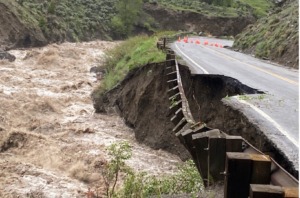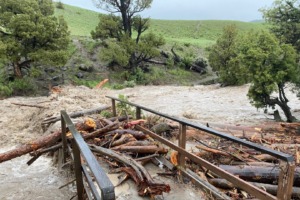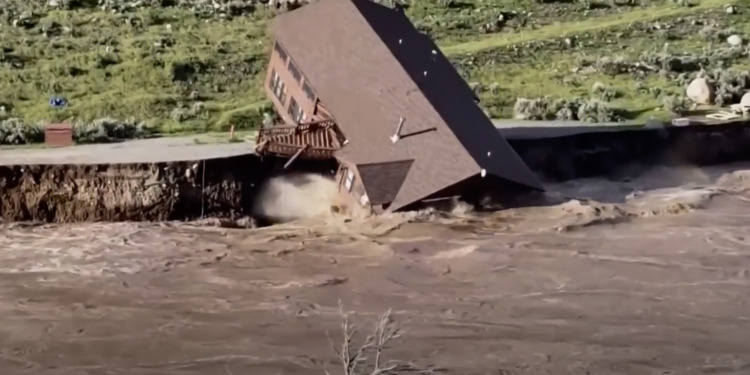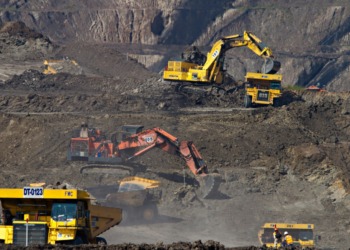On Monday, heavy rain and snowmelt from the southern Montana and northern Wyoming region led to disastrous flooding in the Yellowstone National Park, potentially closing the park down for the entire peak tourist season.
The record-high flooding led to 10,000 visitors being evacuated as well as to a plethora of bridges, roadways and cabins being destroyed, and to crucial electricity and water infrastructure being damaged.
Being the oldest National Park in the United States, centuries of weather have led to the unique formation of the Yellowstone landscape — yet the latest flooding may have altered the park’s terrain forever.
What happened?
According to the National Weather Service, heavy rain and melting mountain snow led to the record-high water levels at the Yellowstone, Stillwater and Clarks Fork rivers.
Yellowstone River at Corwin Springs reportedly rose to 13.88 feet (4.2 meters) on Monday, which is almost a meter higher than the previous record-height set in 1918 at 11.3 feet (3.5 meters).
Into the following day, high waters in the rivers led to these historic flood levels, sweeping away cabins, damaging nearby small towns, altering and tearing apart roads and bridges as well as cutting off power to thousands of visitors.
Some of the biggest damage occurred to small neighboring towns where tourists typically stay. According to Carbon County authorities, roughly 200 homes were flooded in the Red Lodge and in Fromberg, Montana.
In south-central Montana, flooding from the Stillwaters River stranded 68 people on campgrounds, with local emergency service agencies having to evacuate people by raft.
Hundreds of tourists staying in Gardiner, Montana, were also stranded until authorities were able to reopen a partially washed away road the following day.
Except for a few backpackers, most of the park’s thousands of visitors have been evacuated — and no one has yet died or been injured. Wildlife is likely expected to have sustained no injuries.
The flooding has also led to mudslides and rockslides across several Montana counties. Photos taken by the National Park Service showed mudslides and rockslides washing away homes and damaging roads, which may have to be permanently replaced or relocated

While the water started to recede on Tuesday, the full extent of damages is still unknown.
Officials have already assessed that most damage occurred in the northern part of the park and Yellowstone’s gateway communities in southern Montana.
Alongside damage to man-made objects, the flooding affected the terrain, pushing a popular fishing river off course that could possibly be changed for good.
Will the park reopen?
According to Superintendent Cam Sholly, the park could remain closed up to a week, while more damaged parts — like the northern side of the park, where mudslides and rockslides damaged roads and bridges — may remain closed for the rest of the summer.

Keeping the north side of the park closed will deter accessibility to several of the parks main tourist attractions, including Tower Fall, Mammoth Hot Springs and the Lamar Valley — the area of the park known for viewing bears and wolves.
Luckily, tourists may get to see some popular attractions located in the park’s southern loop road, such as the Old Faithful, Yellowstone Lake and the Grand Canyon.
Despite the possibility of half of the park being reopened, the northern park’s inevitable closure will have a significant impact on the tourist season — something Yellowstone has been deprived of during the COVID-19 pandemic.
A typical tourist season lasts throughout the summer and doesn’t decline until fall. Last year at this time, four million tourists were tallied at Yellowstone.
This means that the local businesses around Yellowstone will be impacted not only by the destruction caused by the flooding, but by the significant drop in tourist visits as well.
According to Bill Berg, a commissioner in nearby Park County, businesses in hard hit places like Gardiner were hoping for a good year after they just started recovering from the COVID-19 pandemic. “It’s a Yellowstone town, and it lives and dies by tourism, and this is going to be a pretty big hit,” Gardiner said. “They’re looking to try to figure out how to hold things together.”
Climate change: Was it the cause?
The flooding at Yellowstone National Park hit just as high temperatures wreaked havoc across the U.S.
At the moment, both the Midwest and East Coast areas are facing severe heat waves, while parts of the West are burning from an early wildfire season due to severe drought that has plagued the West for roughly a decade now.
On Monday, these abnormally high temperatures in the Midwest and heavy rainfall led to the rapid melting of snow over the weekend, which produced a foot of water runoff.
According to CNN Weather Calculations, the extreme rainfall and fast-paced snowmelt led to the Yellowstone area receiving two or three months worth of rainfall in just three days.
Yet this extreme weather wasn’t a surprise to scientists who predicted the flooding of Yellowstone roughly a year in advance.
As the report published last year by scientists concluded, the climate crisis would lead to significantly more rainfall and fast-paced snowmelt due to extreme spring and summer temperatures.
In the report, scientists with the U.S. Geological Survey, Montana State University and the University of Wyoming observed how the climate has changed from 1950 to 2018 and how it would continue to change based on greenhouse gasses until the end of the century.
The report found average temperatures in the Greater Yellowstone Area rose to 2.3 degrees Fahrenheit since the 1950s and could potentially increase another five to degrees.
Alongside temperature, rainfall was also suspected to increase in the near future by between 9% and 15% — yet at the same time, high temperatures are predicted to lead to worsening drought conditions as well.
At the end of the report, scientists concluded that the Yellowstone National Park will eventually see what the West has been seeing for decades-long periods of drought, with sudden uprisings of heavy rainfall from high temperatures commencing in waves of dangerous flash floods.
Monday’s flooding in Yellowstone National Park seems to be the start of a dangerous, and exhaustive, climate-change-induced cycle that will likely happen again and again, unless we stop warming the globe.
Editor’s Note: The opinions expressed here by Impakter.com columnists are their own, not those of Impakter.com — In the Featured Photo: Cabin falls into river amid severe flooding in Yellowstone National Park. Source: CBS News.










